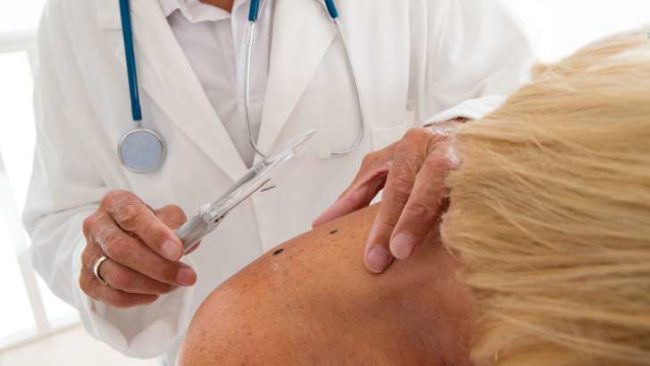May is Skin Cancer Awareness Month, with “Melanoma Monday” focusing attention on the deadliest form of the disease. It’s curable if spotted early, but doctors say patients need to be a partner in the process.
“Everyone should get really familiar with their own moles because that’s what’s going to save your life,” Dr. Julie Karen, a board certified dermatologist in New York, told TODAY.
Your doctor should be checking areas of your body where you may not even realize you can get skin cancer, including the scalp, eyelids, between your fingers and toes, and behind the ears, said Dr. Debra Wattenberg, a New York dermatologist and founder of NY Skin RX.
1. You notice an ‘ugly duckling’ mole
Pay attention to a mole that doesn’t look like any of the others on your body, or is the lone mole on an otherwise spot-free part of your anatomy.
“A lot of people have moles that look sort of scary, but they’ve got 20 of them on their arm or their back,” Wattenberg said. “And then they have one that’s totally different looking. Usually, it’s the ‘ugly duckling’ — the one that stands out — that’s problematic.”
Moles you’re born with can develop into skin cancer, she added. And just because you have a new mole, it doesn’t mean it will it turn out bad, but we get fewer new moles as we get older.
2. There’s a vertical dark streak on your nail
“People often don’t think that you can get melanomas of the nail,” Karen said, noting it’s more common among African-Americans. Singer Bob Marley was 36 when he died of acral lentiginous melanoma, which first showed up as a dark spot under his toenail and spread to his liver and other parts of the body.
The cancer can look like a pigmented black or brown streak extending the length of your nail. Or it can be mistaken for a blood blister that stays towards the base of the nail — the cuticle area — and never grows out.
Remove nail polish from your toes and fingers when you go for your skin check, Wattenberg advised. It’ll help your doctor find any linear streaks that could be melanoma, or bumps that could be basal cell or squamous cell skin cancer.
3. You experience vision problems
The second most common type of melanoma is melanoma of the eye, said Dr. Sapna Patel, a melanoma oncologist at MD Anderson Cancer Center in Houston. Just like you’d have a mole on your skin, a spot can appear in the back of the eye. Doctors will only discover it when you get your pupils dilated during an eye exam.
Less than half of patients will actually have symptoms, Patel said. If you do have them, they may show up as blurry vision, floaters, a growing dark spot on the iris, and other issues.
4. You have a ‘pimple’ that won’t go away
Basal or squamous cell skin cancer can look like a zit that doesn’t clear up after a few weeks, a sore that won’t heal or a scab that keeps recurring.
The “pimple” also may go away and come right back in the same spot, and it won’t have pus when you squeeze it, Wattenberg noted.
5. You notice a mole on the sole of your foot
Many people have benign spots on the soles of their feet or the palms of their hands, but they should be checked out, especially if the mole is new or changing.
The problem is that people often don’t think to look for moles on the bottom of their feet and many aren’t limber enough to check there, Patel noted.
6. You experience changes after having a mole removed
If you’ve had a mole removed and you start seeing pigmentation that’s extending outside the scar, that’s extremely concerning, even if the original mole was benign, Karen said. A mole that’s spreading beyond its initial footprint means it has now changed or progressed.
Be sure to tell your doctor if you spot a lump or a bump that occurs near the scar, or if you feel pain in that area.
7. There’s a black spot inside your cheek
Another less-known location where you can get melanoma is in your mucous membranes, Patel said. That includes inside your cheek, nasal cavity, anal region and the vagina.
“None of these are caused by the sun,” she noted. “We’re not sure why people get those, which is important that people get their mucous membranes examined.”




